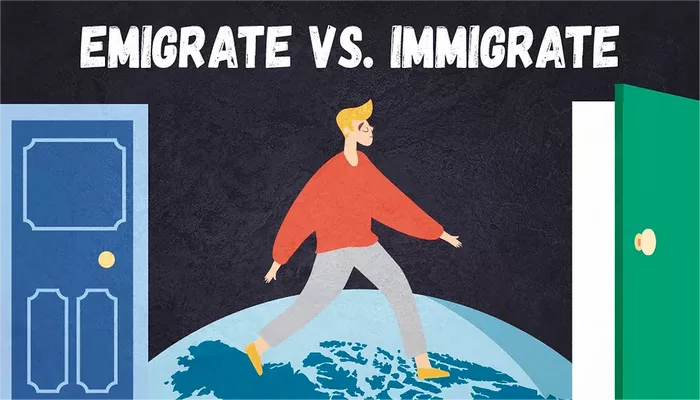Immigration and emigration are two terms often used interchangeably, but they represent distinct aspects of human migration. In the global landscape, movements of people across borders are complex phenomena, influenced by various factors such as economics, politics, and social dynamics. To comprehend these processes accurately, it’s crucial to grasp the nuances between immigrants and emigrants.
Defining Immigrants and Emigrants
Immigrants and emigrants are both individuals involved in the migration process, but they occupy different roles within it.
Immigrants are individuals who move into a foreign country with the intention of settling there permanently or for an extended period. They leave their country of origin, often seeking better economic opportunities, political stability, or improved quality of life. Immigrants may undergo legal processes such as obtaining visas or residency permits to enter their destination country.
Emigrants, on the other hand, are individuals who leave their country of origin to settle in a foreign country. They are departing from their homeland, typically seeking similar motivations as immigrants. Emigration involves leaving one’s place of residence to establish a new life elsewhere. Emigrants may also navigate legal procedures depending on the immigration laws of the country they wish to move to.
Key Differences Between Immigrants and Emigrants
1. Direction of Movement: The primary distinction between immigrants and emigrants lies in the direction of their movement. Immigrants move into a foreign country, while emigrants move out of their country of origin.
2. Point of Reference: The terms immigrant and emigrant are relative to the perspective from which migration is observed. For instance, an individual leaving Italy to settle in the United States would be considered an immigrant from the U.S. perspective and an emigrant from the Italian perspective.
3. Legal Status: Immigrants and emigrants may face different legal requirements and procedures based on their status in their destination country. Immigrants often need to obtain visas, residency permits, or citizenship, whereas emigrants may need to fulfill exit requirements or obtain documents such as passports from their home country.
4. Integration Process: Immigrants and emigrants may encounter distinct integration processes in their respective host countries. Immigrants may undergo processes such as cultural assimilation, language learning, and adaptation to local customs. Emigrants, meanwhile, may face challenges related to adjusting to a new environment, establishing social networks, and maintaining connections with their home country.
5. Economic Impact: Both immigrants and emigrants can have significant economic impacts on their home and host countries. Immigrants may contribute to labor markets, entrepreneurship, and economic growth in their host countries. Emigrants may send remittances back to their home countries, providing financial support to families and contributing to local economies through investments upon return.
Factors Influencing Immigration and Emigration
Several factors drive immigration and emigration, shaping patterns of human mobility across the globe.
1. Economic Opportunities: Economic disparities between countries often drive individuals to seek better opportunities elsewhere. Immigrants may move to countries with stronger economies and job markets, while emigrants may leave areas with limited economic prospects.
2. Political Stability and Security: Political instability, conflict, and persecution can prompt individuals to flee their home countries in search of safety and security. Immigrants may seek refuge or asylum in countries offering protection and stability, while emigrants may leave areas affected by violence or political unrest.
3. Social and Cultural Factors: Social and cultural factors, including family reunification, education opportunities, and quality of life considerations, influence migration decisions. Immigrants may move to be with family members or pursue educational and cultural experiences, while emigrants may seek environments that align with their lifestyle preferences and values.
4. Government Policies: Immigration and emigration are influenced by government policies and regulations related to border control, visas, residency permits, and citizenship. Immigration policies can shape the flow of migrants into a country, while emigration policies may affect the ease of leaving a country.
5. Globalization and Technology: Globalization and advancements in technology have facilitated greater interconnectedness and mobility across borders. Transportation networks, communication platforms, and digital technologies have reduced barriers to migration, making it easier for individuals to move between countries.
Challenges and Opportunities
While immigration and emigration offer opportunities for individuals to pursue better lives and contribute to diverse societies, they also present challenges for both sending and receiving countries.
1. Integration Challenges: Immigrants and emigrants may face barriers to integration, including language barriers, cultural differences, discrimination, and social isolation. Host countries may struggle to provide adequate support and resources for newcomers, leading to issues of social cohesion and inclusion.
2. Brain Drain and Brain Gain: Emigration can result in a phenomenon known as brain drain, where highly skilled individuals leave their home countries, depriving them of valuable human capital. Conversely, immigration can lead to brain gain, as skilled migrants contribute their expertise to host countries’ economies and innovation ecosystems.
3. Social Tensions and Xenophobia: Immigration and emigration can sometimes fuel social tensions and xenophobic attitudes, particularly in countries experiencing rapid demographic changes or economic challenges. Negative perceptions of migrants may arise from fears of competition for jobs, strains on public services, or cultural differences.
4. Policy Responses: Addressing the complexities of immigration and emigration requires comprehensive policy responses at local, national, and international levels. Effective policies should balance the interests of migrants, host communities, and sending countries, while upholding principles of human rights, dignity, and social justice.
Conclusion
In conclusion, while immigrants and emigrants both participate in the migration process, they represent distinct roles within it. Immigrants move into foreign countries seeking new opportunities and experiences, while emigrants leave their home countries in pursuit of similar aspirations. Understanding the differences between immigrants and emigrants is essential for comprehending the complexities of human migration and developing informed policies and responses to address its challenges and opportunities.


